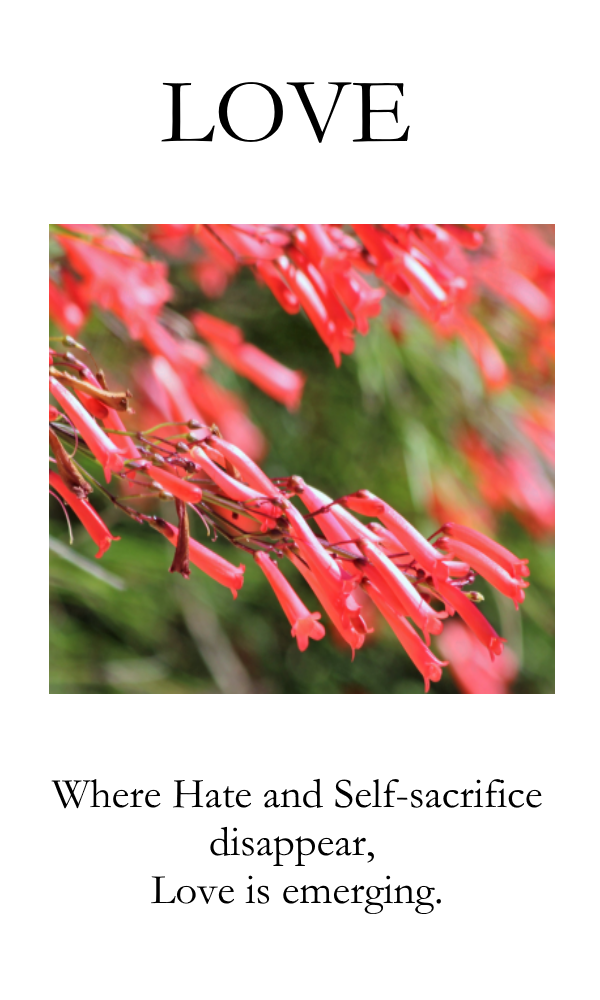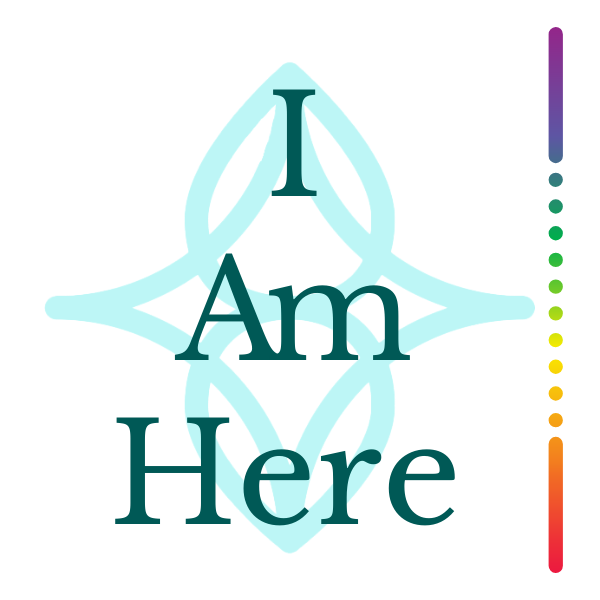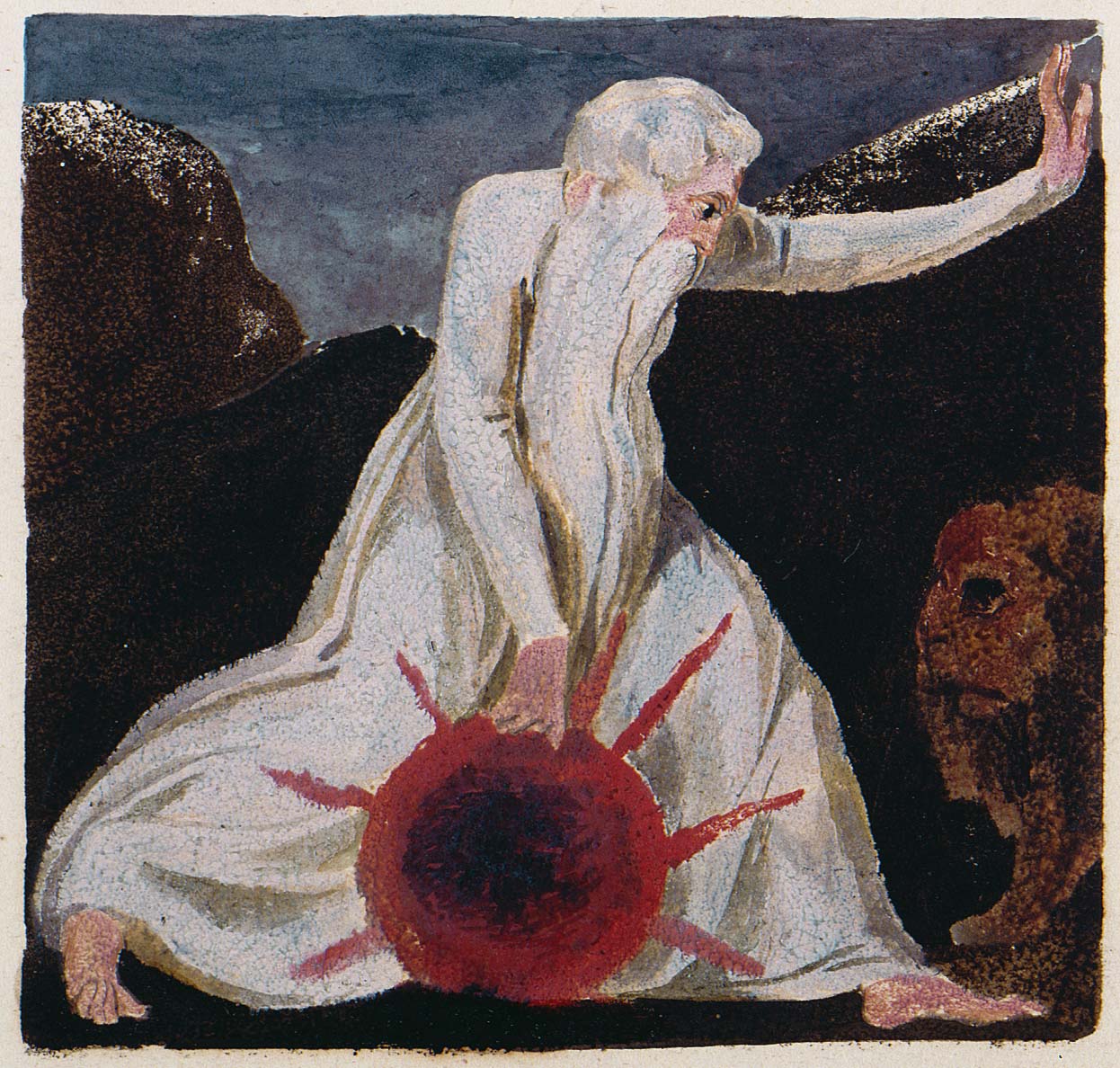“Hatred paralyzes life; love releases it. Hatred confuses life; love harmonizes it. Hatred darkens life; love illuminates it.”
MARTIN LUTHER KING JR
Hate is not the opposite of love. The partner of hate is sacrifice. In love, sacrifice and hate are one.
Hate
Perhaps the most injurious way to degrade love is found in the belief that love is in competition with hate. By moving love into the world of duality, endless war is generated between good and evil, in which both parts move with hatred and call it love. Love is not the opposite of hate. Hatred is one of the most potent contractions of love. Love is there always, but hatred utterly depends on love in order to manifest.
Hatred could be described as frozen love, or love in a state of shock or trauma. Energetic dissonance in the form of rejection or abuse generates an existential threat. Love becomes shocked by conditions. These conditions polarize love within the forms of punishment and reward. When the naturalness of connection through love meets dissonance, pain comes forward. We retract from ‘the other’ and the love that would have been there in naturalness forms a barrier between one ‘person’ and the ‘next’, or a divider between inner and outer worlds. The direct experience of this dissonance is pure suffering.
When we look toward animals, we might witness moments of hatred. These are a kind of communication about safety and boundaries, which can resolve quickly into an atmosphere of peace. Hatred in naturalness is a rapid, energetic signal. It is when we grasp at it that it becomes the brooding, compulsive contraction that we recognize in humans.
Although it can feel cold-blooded, hatred is far from neutral. As much as love, it follows the law of attraction to fix on its target. It focusses consciousness on the object of hatred, charged with frustration, accusation, judgement and condemnation. It actively creates its target as a form of rejection. It is enflamed by the inner pain projected outwardly, yet is charged by the agony of thwarted love.
When hatred has been prohibited as a natural reflex, then the client will make the ‘other’ at cause of the hatred, abnegating power and responsibility. To feel hated is slightly less horrible than to experience direct hatred towards another, and when it’s the other’s fault, we can still perceive ourselves as ‘good’. This is partly because shame at the forbidden emotion of hatred is avoided. But it’s a short-term fix. When we externalize hatred as sourced in the other and directed towards the self, we are moving into the area of the persecuted – a structure of identity that can pass from one generation to another. Out of this artificial state of victimhood, we steal a sense of legitimacy for abuse, violence, war and genocide. We exempt ourselves from responsibility, as it is ultimately the fault of the ‘other’.
Hatred is a rapid, sentient reflex that is sourced in love. It gains status and separate form when it is denied and seeks justification through horizontal release (through projection on others or on the world). The art is to allow the aversion without identifying with it and without breaking connection with the impersonal, unconditional love in which it is sourced (ourselves). That is, to allow a deeper source of unlimited love to surround and affect the freeze of hatred: to love and hate at the same time. Aversion is a source of information for navigation. In no way does unconditional love affirm or seek to maintain the dissonance of hurtful behavior. On the contrary, it disempowers those behaviors, revealing them as aberrations.
When we can release the external targets of our obsession and begin to surround the ice of hatred within ourselves with the warmth of love, then it begins to melt back to Source. This doesn’t render us defenseless, rather, it brings wisdom and peace which are fundamental Nondual Qualities connected to resilience in trauma.
When we are seated in the heart, the ‘other’ is not the source of love, nor is it the source of hatred. In fact, out of the power of unconditional love, the concept of ‘otherness’ itself begins to evaporate.
Sacrifice
The identification with being persecuted through the externalization of the source of hatred ‘outside’ ourselves is one way to avoid responsibility for the unconditional suffering of hatred within our field. When this denial of the energy of hatred is taken to extremes, we begin to move into the partner of hatred which is self-sacrifice. We can so hate the energy of hatred that we would rather sacrifice our deeper needs, the truth of our experience, and the naturalness of expression than allow it. While the sacrifice of our short-term desires and personal agendas for the sake of love can be evolutionary, self-sacrifice born from the agenda to keep possession of love will bring misery. Love is taken hostage by a traumatic break in manifestation.
Cultural conditioning has created a tendency for the contraction around love to be more expressed as hatred by men and more as self-sacrifice by women. Yet where there is hatred, there will also be a sense of victimhood and inordinate sacrifice, just as where there is self-sacrifice, there will be an unvoiced vibration of hatred, often in the form of secret contempt.
Where there is a pattern of self-sacrifice, we are witnessing an internal split in the psyche. Who sacrifices who? Is the perpetrator not an internalized form of hatred? Self-sacrifice as a feeling has a sensation of injury, affliction and loss about it. It is quite different from the movement of expansion that allows release or letting go from the limitations of form. It has an inner violence to it. The underground thoughts to this implosion can be along the lines of: “I hate myself”; “I want to kill myself”; “I should be dead”; “I want to disappear.”
Where suicidal thoughts (the compulsion of one part to destroy another part), are also prohibited, then patterns of self-destruction can come forward, often looking like suicide in slow motion including eating disorders, cutting, addiction, neglect and chronic depression. In the extreme physical form, the contraction plays out as Suicide Versus Murder, in which the Nondual Quality that is sought is unconditional release.
The energy of self-sacrifice can be suffused with self-pity, resulting from the constant inner humiliation. All this is happening within a severe inner split of the psyche. One part of the psyche sacrifices the other part, or one part hates the other part. There is a split between victim and perpetrator in which the default identification tends to mostly lean towards victimhood. This complicates the natural movement of love. The child that shows his pride in a daisy chain and is slapped by his father, or the teenager in puberty who is sexually shamed by her parents, are examples of the kind of shocked love that can result in the sacrifice of an area of manifestation. These traumas of disconnection petrify the flow of energy in a contraction between inner and outer worlds, and between the personality and its Nondual Source. The freeze between the individual and the whole can starve the psyche of vitality, increasing the addiction to the authority of externalized love.
Identified as the victim rather than the perpetrator, the self-sacrificing personality structure can develop as a thinly veiled strategy to control, manipulate and evade the charge of unrestrained love. As manifestation is muted, personality becomes unstable, lacking affirmation. Every form of personality contracts the moment it is touched. When love is there, it can feel threatening, and trigger a surge of pain. A vicious cycle can take form: the fear-based agenda of self-sacrifice perpetuates more fear as the personality is disempowered; this generates physical and psychological weakness which perpetuates more dependency on outer sources of power.
Within the duality of hatred and sacrifice, we find the fundamental belief structures of Me Versus You; Them Versus Us; or Me Versus the World. In this we are talking about the last line of defense of the Separate Self.

Love: Nondual Quality
All that we can see, feel, or know is nothing other than the effects of love. The willingness to let our consciousness dive into the cause before the effect – the spacious mystery before the feelings of love – is critical to the allowance of love. When we make this leap in the dark, we release agendas of grasping and aversion. Suffering is inherent to creation, and in so many ways, love is suffering. Therefore, ‘letting go’ (which is not the same as self-sacrifice) has become a catchphrase. When we let go even of the energetic agendas of seeking love, finding it, getting it and keeping it, we allow the imperceivable intelligence of the source of love itself.
Love creates through division and destroys through reunion. Its power underpins every conflict and each contraction. It combines, confuses and collapses us back into the more spacious dimensions of being. It is inherent to each sense perception and every seeing. It is both the glue of creation and the fabric of form. When one form of love meets another form of love, there is an explosion of love in which only love remains.
Love can give us the power to move mountains and it can leave us faltering in pure vulnerability. It can be a prerequisite to give it, yet a torture to receive it. It is found in the softest touch of the breeze and in the unflinching certainty of emanation. It heals and liberates, makes us feel safe, while infinitely escaping us. Just as it drives us into the world, it calls us home, deep inside ourselves. It is found in every coming and going, beginning and ending, emanation and disappearance, birth and death, yet it will lift us beyond all those illusions.
To gain insight into love, consider the attraction towards the beloved: if we allow this attraction, all the way into the beloved, taking the beloved all the way into the Source of all we are, would we still see the beloved? Would they not be one with all we are? Was this love creative or destructive?
In naturalness, interdependent, interconnected forms move through love and channel it through denser vibrations, all the way into the physical cells of the body and the fundamental particles of matter to a point of absolute singularity where love is no longer perceivable as it is identical with the perceiver.
This is what makes love so difficult to define. What is it that can be at once everywhere and nowhere? In everything and at the same time in nothing? Again, we know love by its effects. When we dive into the imperceivable source of love, those effects accelerate – there is a quickening of transformation.
Just as self-sacrifice longs to belong, love is found in the longing. Just as hatred conspires to stop suffering, love is found in the suffering itself. Love plays out in the dynamic of consciousness at the borders between densities of form: between the Source and the psyche, between the psyche and the body, and between the body and the planet. It is the feeling quality in every touch of form.
It is therefore important to allow this love within the suffering of our contractions. This allowance is radically different to the agenda of ‘getting rid’ of our suffering. In this way, suffering is not the ‘other’, it is not a threat, but a lost child coming back to love, as love.
Love is the power out of which consciousness is born. It arises spontaneously out of the space between and within all forms to reunite through form, in full transformational unfolding. Love pulls towards harmony and expands from within each contraction.
This love is not mine, nor yours: it precedes both you and I. It can’t be possessed, won or lost, as it outlives us all. Know love through its effects, opening the heart, clearing the soul of obstruction, loving even obstructions into reunion with all that is.
Here, I am always, already in Love
[Nondual affirmation]
“Your task is not to seek for love, but merely to seek and find all the barriers within yourself that you have built against it.”
Rumi




